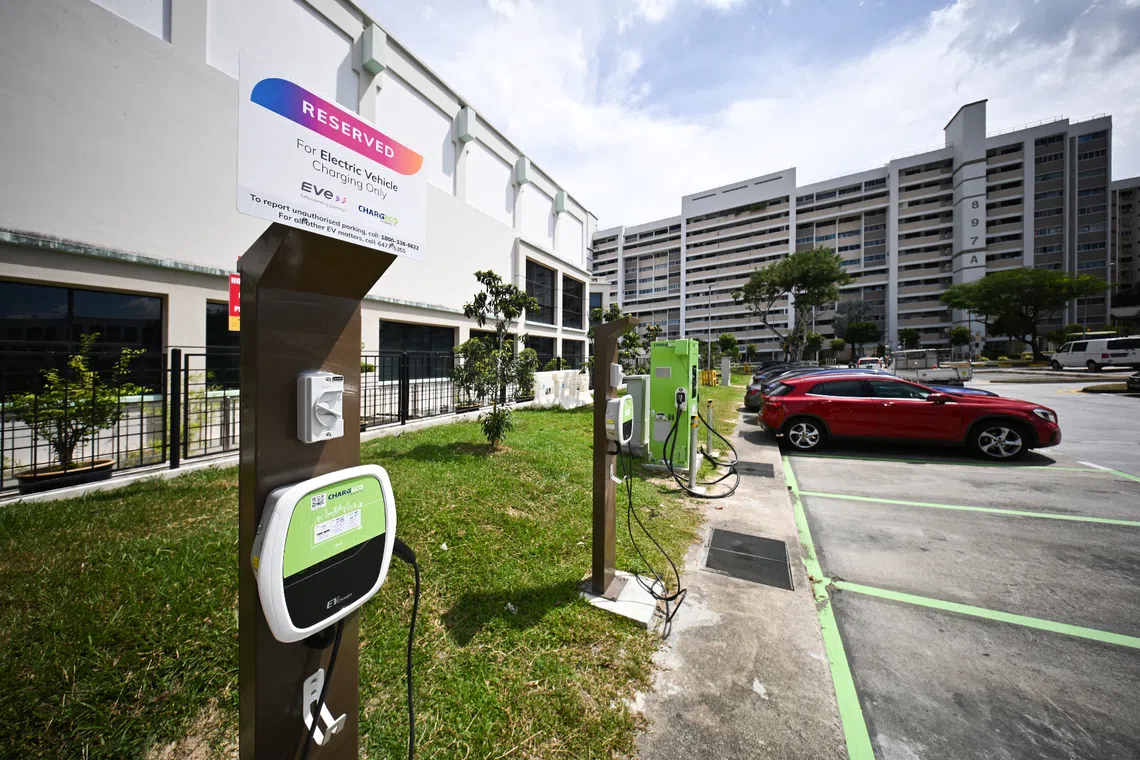Over 1,600 HDB carparks now have EV chargers; 150 more to get them by end-2025
Sign up now: Get ST's newsletters delivered to your inbox

Electric vehicle charging points at a carpark near Block 828 Tampines Street 81. More than 1,600 HDB carparks now have EV chargers.
ST PHOTO: LIM YAOHUI
Follow topic:
- Over 80% of HDB carparks have EV chargers, with the remaining 300 getting at least three 7.4kW charging points each.
- Installation in 150 carparks will be done by end-2025, and the other 150 will follow, delayed by "technical constraints" and community needs.
- Some residents benefit from the new chargers, while others face issues such as a lack of chargers or hogging, causing frustration and inconvenience.
AI generated
SINGAPORE – About 85 per cent – or over 1,600 of some 2,000 – Housing Board carparks have been equipped with chargers for electric vehicles (EVs), with another 150 carparks to get them by the end of 2025.
However, the remaining 150 carparks will get these chargers installed only from 2026. This is due to factors such as “technical constraints” and “taking in community preferences to balance the parking needs of various users”, said the Land Transport Authority (LTA) in response to The Straits Times’ queries.
This means the authorities will miss their target of equipping every HDB carpark with EV chargers by the end of 2025.
LTA said it will deploy at least three 7.4 kilowatt (kW) charging points at each of the 300 HDB carparks that currently do not have EV chargers. Such charging points are slow and suitable for overnight charging.
Some of these upcoming locations are in Fernvale Road, Ang Mo Kio Street 22 and Eunos Crescent, according to checks by ST.
Estates currently without EV chargers at HDB carparks include some Build-To-Order (BTO) projects in Tengah and Bidadari, as well as in Tampines West.
Some car owners, such as Tampines resident Sam Wong, 37, told ST they have benefited from the installation of EV chargers at HDB carparks.
With the recent set-up of 18 new 7kW EV chargers at the carparks near his Tampines GreenVines flat, the data analyst finds it more convenient to charge his car close to home – he has been able to find an available charger every time he wants to charge his vehicle.
Before that, Mr Wong had to do his charging “more intentionally”, by doing so at carparks of shopping malls or places he visited whenever possible – especially since there were also no EV chargers at his workplace.
In a written response to a parliamentary question on the deployment of EV chargers in public carparks, Acting Transport Minister Jeffrey Siow said on Oct 14 that the authorities will continue to keep up with the latest charging technology.
He added that they will work with the community, as well as EV charging operators, to scale up the installation of EV chargers in carparks with high charging demand, as long as there is enough electrical capacity.
Most 7.4kW chargers at HDB carparks can take more than two hours to dispense the same amount of electricity
The majority of the EV chargers at HDB carparks are slow and suitable for overnight charging.
Information technology associate Aloysius Wong, 35, just moved into his new BTO flat in Kebun Baru Edge in Mayflower estate, where there are no EV chargers.
While there are several slow chargers at the nearby Kebun Baru View development, Mr Wong would have to pay for at least five hours of parking every time he charges his EV there. Hence, he prefers using other public fast chargers to quickly juice up his car.
“Ultimately, I feel really frustrated that it’s taking so long to install chargers at my place, where it would be the most convenient for me to charge my car,” he added.
Mr Manpreet Toor, 37, experiences a different kind of frustration: There are three EV charging points at the multi-storey carpark near his flat in Teban Gardens, but these spots are often occupied, he said.
So the bar owner has to charge his EV at a 120kW fast-charging station at a nearby factory in Penjuru, which is a five-minute drive away.
He added that the situation is worsened by the fact that residents continue hogging the EV charging stations after their vehicles are fully charged because there are no idling fees imposed on them.
Some EV charging operators, such as SP Mobility and Shell, have rolled out idling fees for vehicles that overstay in charging spots.
Noting that there are around 10 residents in his estate who are EV owners, Mr Toor hopes to see more EV chargers installed at his flat’s carpark.
LTA said there are also more than 3,600 EV charging points installed across over 900 non-landed private residences – or more than 30 per cent of such developments – here.
In total, there are more than 25,000 EV charging points islandwide, half of which are publicly accessible, Mr Siow had said.


